
Cinematographer Steve Yedlin recently shot two episodes of Poker Face, one of the best-looking shows streaming right now. Widely known for his collaborations with Director Rian Johnson on movies such as Looper, Star Wars: The Last Jedi, and Knives Out, Yedlin’s work on Poker Face has drawn praise for its grainy texture, dramatic use of lighting, and warm colors. For audiences, it is a reprieve from the drab and lifeless aesthetic popular in TV today, reminding them of the paranoid thrillers of 1970s cinema.
The detective series stars Natasha Lyonne as casino idler Charlie Cale, who possesses the special ability to read a person’s face and tell when they are lying. When this power gets Charlie in trouble with a crooked casino boss (Adrien Brody), she flees Las Vegas and travels across the country, using her powers to solve mysteries in the style of Columbo, but instead of “whodunit,” it’s more of a “howtocatchem.”
Yedlin is the kind of chameleonic craftsman who can combine lighting cues, environmental manipulation, and visual effects to achieve shots that are both gorgeous and kinetic. Drawing from his knowledge of picture development at labs like Kodak and stylized ’70s movies such as The French Connection and The Godfather, Yedlin excels with help from a home-cooked algorithm that processes footage and allows him to cherry-pick visual idiosyncrasies of 35mm film while maintaining the technical flexibility and precision of digital.
Below the Line recently spoke with Steve Yedlin during a break in filming a new Marvel project down in Atlanta, where he discussed working with Rian Johnson on Poker Face, his own style’s contrast to the default look today, his specialized algorithm, and the work of DPs Gordon Willis and Owen Roizman, who were major influences throughout his career.
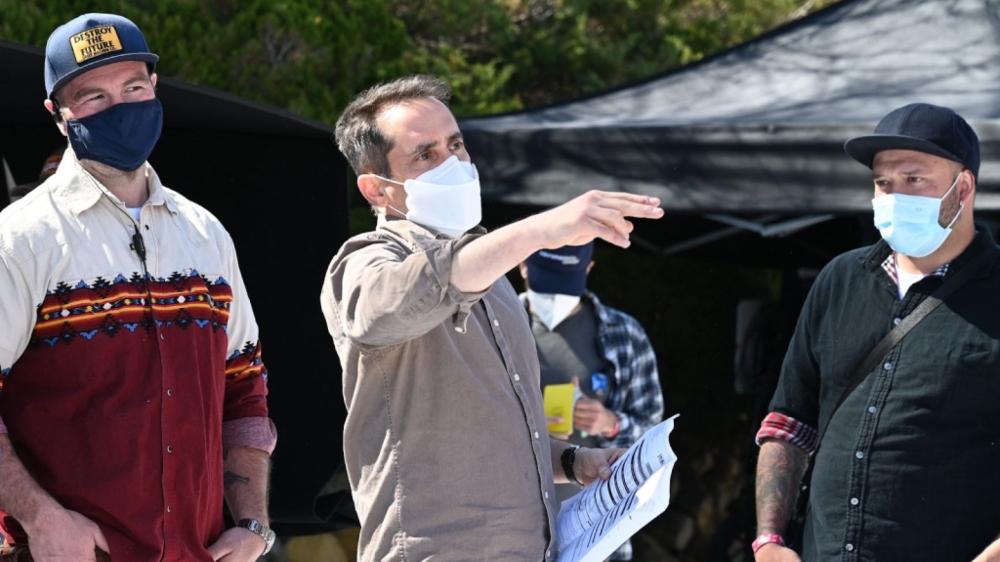
Below the Line: I’d like to start by discussing a couple of my favorite shots from the show and see how you achieved them.
Steve Yedlin: Sure!
BTL: In Episode 1: “Dead Man’s Hand” there’s this shot where Adrien Brody’s character jumps from the balcony and you track him as he falls and follow him all the way to the ground. I thought that was so cool. How’d you shoot that?
Yedlin: Yeah! So, obviously, that’s a visual effect; there’s a composite there. Because Adrien Brody wasn’t falling out of a building [laughs]. So yeah it was one shot, we just tracked him out and he did the whole performance of falling. It was on a set so we could dolly right through the wall — it’s on a stage. He really jumped off the railing and was held up by wires so that when he went off the railing he didn’t fall, he just hung there. But he did the performance of falling, and then they just comped in the background in post — plus, the camera shake and the wind effect. We also did a lighting cue so that it felt like he was going from up high where it’s dark to approaching the lights on the ground.
BTL: Wow. That’s very inventive. When I first saw that, I imagined you put the camera on a crane and dropped it, but I guess it makes way more sense the way you described it.
Yedlin: That’s great if that’s what it felt like.
BTL: It did.
Yedlin: Awesome.
BTL: In that same episode, there’s a shot where Natasha Lyonne’s character is outside her trailer — and in general, the shots at the trailer park have this great use of naturalistic lighting that you don’t get in places like the casino — and I noticed that when she’s sitting in the chair outside her trailer, there’s a lens flare. Was that intentional, and if so, can you tell me about that decision? It makes the shot look very striking…
Yedlin: One of our cinematographers, Christine Ng, shot four episodes. She shot that scene because it was part of the desert unit, which was shot separately from the main unit. So I wasn’t actually there for that shot [laughs]. But yes, in general, the philosophy that Rian and I have is that we don’t shy away from flares.
There’s the old-school Hollywood thing where flares are a mistake and you avoid them, but there’s this new-school thing where people are going crazy and just trying to get lenses to flare and I think our approach is sort of in the middle. Let’s just tell a beautiful story, and flares happen the way they happen in real life, where, like, your windshield’s dirty and you see a flare from the sun.
BTL: Right.
Yedlin: So we allow them to happen. And we embrace them when they do, but we’re also not bending over backward to get them. So in that case, it’s just about, “what is beautiful light for this scene?” And if a flare is part of that, then great! The other thing is, we — especially more recently — lean towards higher-performance lenses, which is not in fad right now. The fad right now is vintage lenses and custom-detuned lenses that actively make them worse, and my philosophy on that is that the audience isn’t supposed to see a lens, they’re supposed to see through a lens.
All lenses exist in the real world, so a quote “high-performance” lens — it’s not like it doesn’t flare or have any idiosyncrasies, it’s just that they’re much more manageable than the crazy ones. To me, I don’t mind leaning into those idiosyncrasies to a degree, but by using the higher-performance lenses, it allows us to go bigger in the concept of what’s happening in the shot without leaning on the lens model to make the look. If we design [a] look that has something very big and bold going on, the lens isn’t going to stop us from doing that and it can handle it.
BTL: Very interesting. In Episode 9: “Escape from Shit Mountain,” there’s this shot where Joseph Gordon-Levitt’s character is on the road and he’s cast in the red light of a car’s taillight. I thought that was, obviously, an aesthetically pleasing shot, but I also loved its menacing undertones as his character took a dark turn. How do you bathe the entire frame in that red light when you’re on location and it’s nighttime? What were some of the challenges?
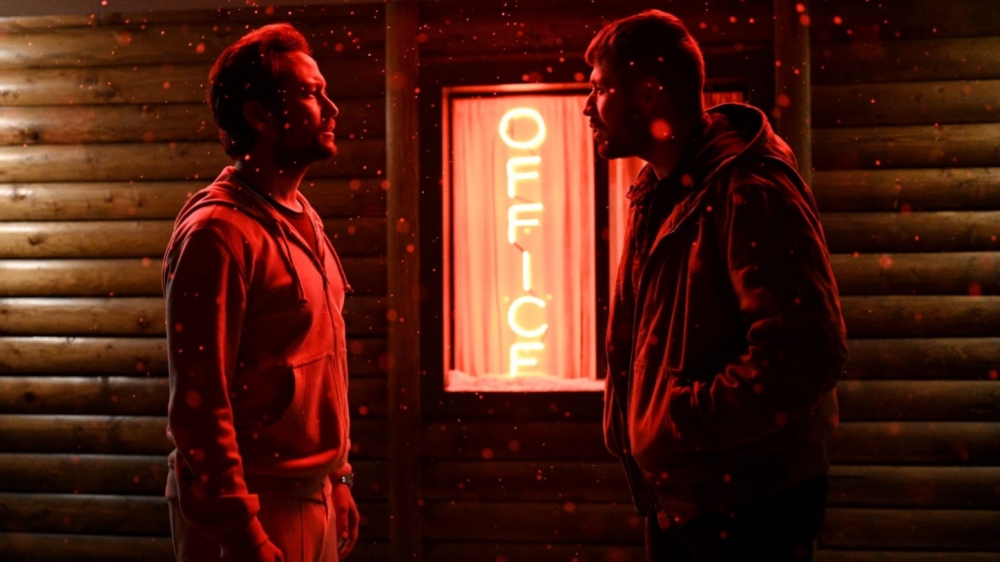
Yedlin: Yeah, that scene is a great example of how Rian and I work together because that concept is so deep in what Rian wanted that it’s [at] the script level, even. It’s not like we were throwing ideas around like “Hey, maybe it looks like this!” It was always, for sure, that look.
So on the one hand, he’s going in with all of this confidence — he’s not asking me to pitch 10 different things and then picking one. We already know what it is. But on the other hand, he trusts me to figure out the details [and] doesn’t micromanage me. He’s not like ‘How are you gonna do this red light thing?’ You know what I mean?
BTL: Yeah. That’s great.
Yedlin: He’s absolutely confident [in] his level of specificity as a director that this is what he wants, but he’s equally confident on the [kinds of] specificity that [are] too narrow for him and that’s my domain. He trusts me to do it. So, in that case, it really was just red lamps for the shot that were supposed to be taillights with a bit of red fill [light].
We had a cutout around the red light so that it actually looked like it was coming from the taillights, but visual effects did help us a little bit where they just fit it onto the car a little better. But there were people who saw the cut before the visual effects were done that didn’t even know it wasn’t the taillight.
BTL: Nice. That’s gotta feel good when you pull off the trick like that.
Yedlin: Yeah!
BTL: With regard to color rendering and so on, is it fair to say your philosophy is thinking of the camera as a data collection tool instead of a look curator, and then manipulating that data with code to achieve certain looks? Is there any reason to cling to film puritanism or should we all just jump ship?
Yedlin: To me, it’s really about being undeceived about what the process is. The reality is, in every system, whether people want to believe it or not, the way the colors are rendered is from a processing pipeline.
BTL: Yes. You discuss this in the demos on your website.
Yedlin: If you shoot film, what would unrendered colors look like? Do you not even process the film? And if you just process the film, then it’s orange, backward, and flat — that’s what negative looks like. That’s not your look. So clearly the idea that the thing is already imbued with a look at that point is just not true. But in the film days, there was a more rigid — not totally rigid — but more rigid pipeline that you kind of had to pick one of a few camera stocks. Sure, you could print it with different printer lights but you had to use printer lights. You had to print it to an existing print stock of which there were only a few. So you could only really make these kinds of trifling tweaks to it.
BTL: I see.
Yedlin: The trifling tweaks that you could make felt like big tweaks. “Oh, I’m gonna shoot this stock instead of that stock,” right? Or, “I’m gonna force process instead of process normally.” But compared to what we have now, where there is simply no absolutely locked-down pipeline, those are trifling little tweaks. To me, it’s really just admitting where the real leverage point is. Today, even if you shoot film, you’re not in that locked processing pipeline.
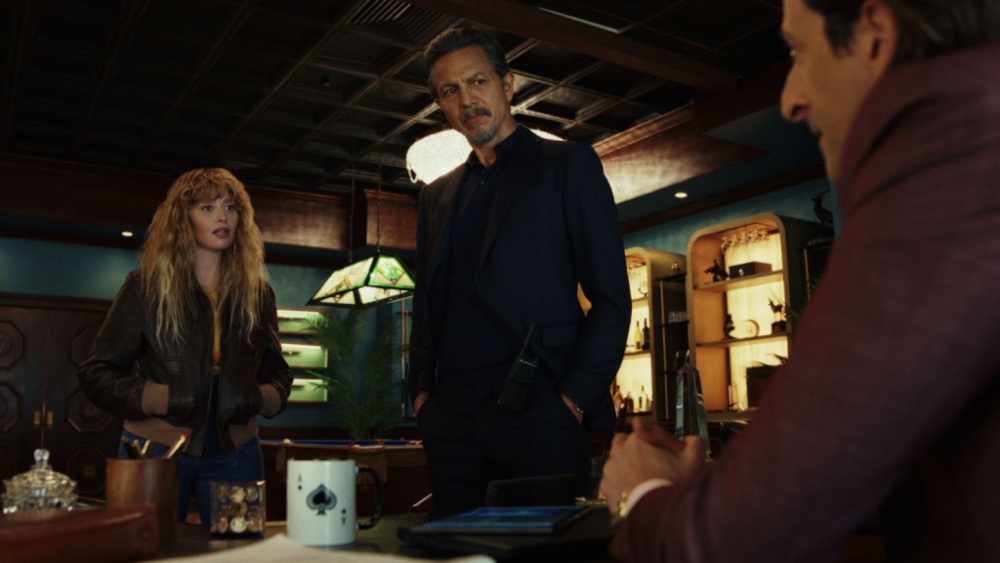
BTL: I notice you use the term “pipeline” often. Could you explain what you mean by that?
Yedlin: The entire computation stack or matrix or whatever it goes through from the very first thing to the very last thing. You know, with a digital kit and pipeline, of course, you have the sensitivity and the analog sensor, then you have any camera processing, and then you have the color and other processing that you choose to do to it for the movie. Plus other things like resizing it to the final format. There are all of these things that have to happen to it one way or another.
And digital photography is exactly like film — it doesn’t have an inherent look that you’re jimmying. You’re always using a process. I’ve had people say to me things like, ‘Why do you do all this work, why don’t you just shoot film?’ And that word “just” shows a lack of understanding from the person who doesn’t have to do the work. Sure you can just use film or somebody could just use my processing pipeline that I use. But thousands of scientists and engineers worked on that film pipeline for over a hundred years that you’re quote ‘just’ using. So the fact that there is any development work at all — thousands of people in a century — that I just used is a bizarre thing. It’s really not understanding the difference between somebody who develops a process and somebody who uses the process.
BTL: That totally makes sense.
Yedlin: Yeah, you know, inventing a camera and using a camera are not the same things. Writing the code for IOS is not the same as using an iPhone. It would be like saying to the people at Apple who developed the software, “why don’t you just use an iPhone?” Because the iPhone doesn’t exist unless you do that, that’s why [laughs].
BTL: So because you have that algorithm now that you have developed yourself as a self-taught coder, which is also very impressive, is there any reason for you to ever look back and use film again? Or do you think you have all the tools now to get the look that you want, to have that sort of grainy, warm colors effect of film but with this new technology — is there any reason for you to go back to the film ever?
Yedlin: I would never want to shoot a whole project on film unless I was forced to for some reason. If there was like a scene in a movie that was supposed to look very degraded, like reversal Super 8[mm film], and I didn’t have time to figure out an “off the shelf” ready-to-go pipeline — in that case, the faster, easier way would be to shoot on some expensive Super 8. But to me, now, I don’t just want everything that film is. I like that I can pick the things that I want and not take the things that I don’t.
BTL: True. Good point.
Yedlin: Because now we’re even starting to alter parameters within the algorithm or altering the algorithms themselves. It’s like, OK, proof of concept, we can make it look like film, but what if we at least figuratively make a new film stock [that] has the stuff that I do like about old film stock but not this other stuff? And also, just the simple things of when you shoot on film, you’’re guaranteed to have blown focus shots in the movie no matter how good your focus puller is. Whereas with digital, you can have either none or fewer, or the ones that are there are so minorly out of focus that you can’t tell.
There’s also a crumbling infrastructure for film. It requires so many experts at so many places — you need all the people at Kodak, at your processing lab, at Panavision. And a lot of the people who really knew that stuff have left the business. They’re trying to train new people who never saw it happening when the infrastructure was there and they’re somehow trying to learn this obsolete thing.
Even the people who are still there from the days when the infrastructure was intact, they’ll often be somebody who was very specialized at that time and now they’re running the whole thing. It might have been somebody who at the lab was in charge of just the chemicals and now they’re doing the whole lab. Or somebody at the camera house who specialized in lenses is now doing everything from film movements to the max. We really don’t have the infrastructure that we had before.
As I came up, all we shot was film because that was the only option [laughs]. This is just an example: in my film days, it was new when they had the kind of movement where there was a CPU [built-in central processing unit] in the camera and it’s actually driving the shutter and the pull-down movement separately. In the old cameras, it was one thing where a wheel was turning and it was making the other go. The CPU driving separately was why they were able to do speed ramping or controlled changes to the camera’s frame rate and shutter speed while the camera is running. The thing is, those cameras were new back then. In all the history of cinema, there have never been 20 or 25-year-old film cameras with electronic shutters.
BTL: Interesting. I see…
Yedlin: When we were doing it, the 50-year-old cameras that still worked were incredibly mechanical and simple and anything that went wrong could pretty easily be fixed. But now you have these crazy technologies that have never been this old before. That’s another thing on top of all the other changes.
BTL: Sounds like that infrastructure will never return in its complete form. Besides your highly specialized algorithm, I think many people complain today that digital cinema, especially in spectacle blockbusters or franchise action movies, looks drab and lifeless. This may also be compounded by the picture compression on streaming, but what is the aesthetic zeitgeist right now and is there anything that you see lacking in it?
Yedlin: Hmm. [laughs] There’s a lot loaded into that question but I think that every era has its bland version. You know what I mean? The people that are doing the best stuff are always unique but there’s always a “this era’s off the shelf” look — the blandest, most common denominator look for any era is not great just like mediocre anything. So I think we could describe the exact character of today’s zeitgeist inertial mediocrity compared to the similar mediocrity from an earlier era.
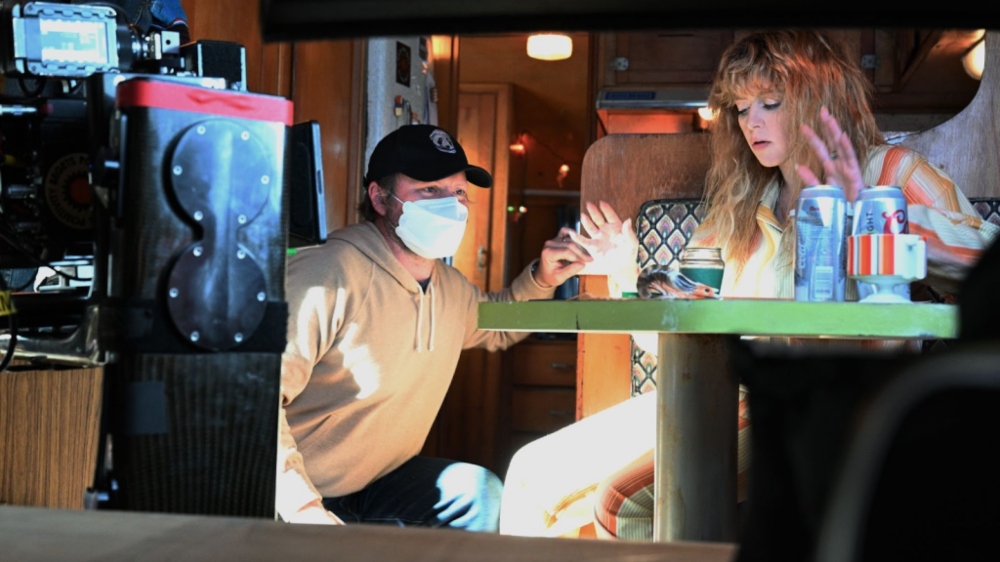
BTL: Definitely.
Yedlin: When people compare something — like, they love the ’70s — so they’re like, “Well look at The Godfather and Taxi Driver. Why don’t things look like that now?” If you just want to pick the absolute best-looking film of an entire decade then of course movies look just as good now. Why don’t you pick some really bland forgettable movies from the ’70s and see how they compare [laughs]?
BTL: True. Nostalgia maybe.
Yedlin: So I think we can dig in and do forensics on how we got to our specific version of what today’s default mediocre look is but I don’t know if that’s really interesting. That’s not the people who are doing the most interesting work today.
BTL: Yeah. And what is that default look a product of? Are there certain technological reasons like the prevalence of a certain lens or camera?
Yedlin: It’s a combination of many things, but I do think it’s true that there’s this processing step that happens whether you believe that it does or not, and the fact that people don’t believe that it does happen and instead are saying, “I’m choosing this camera because of skin tones” or “I’m shooting film instead of digital because of colors or something.” I think this means you don’t understand that part of the process and you’re not doing anything to control it even though it’s a very important step.
You have people doing things like comparing three different camera models or a film camera and a digital camera where they don’t even ask what the processing is. Like, with the digital camera, you just use the manufacturer’s off-the-shelf Look Up Table? That’’ the most bland, generic version. With film, the same thing. “How’s it being scanned? What Look Up Table is it going through?” And there’s sort of incuriosity and over-simplicity happening.
I’ve seen people with their own custom Look Up Table but if you actually look at it, it’s barely different from the off-the-shelf one. It’s not really different, so really, what’s happening is that we’re getting handed this generic look and using it in everything. But that is just one part of it. There’s still all the actual stuff of on-set lighting and shot design. You could do really elevated versions of that even with the mediocre generic Look Up Table.
BTL: Right.
Yedlin: So that is by no means going to be the only explanation for it.
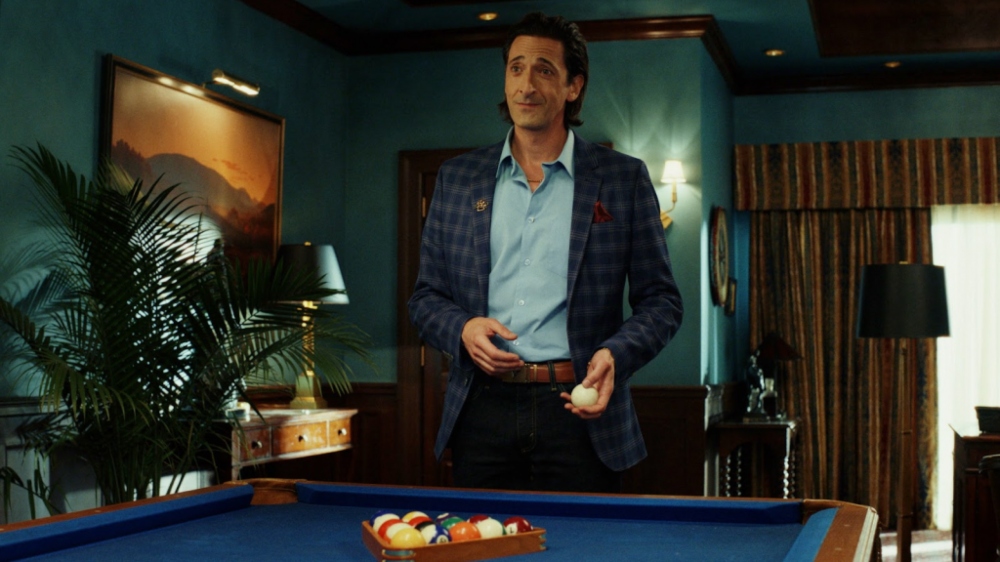
BTL: Yeah, I think when people criticize this aesthetic, many are referring to the overuse or misuse of CGIm where it looks plastic and weightless. You’ve talked about the Gordon Willis top light technique that he used in The Godfather, for example, where he casts strong shadows from high-hanging lights and then diffuses and flags those shadows with black material. You’ve talked about how that technique inspired sequences like one in Adrien Brody’s office and how this helped you make the show look more dramatic. Besides Willis, who are some of your biggest influences cinematographically?
Yedlin: In my approach for Poker Face, the things that were influences were like, “I love that thing, and how can we do something that brings joy without emulating but is similarly inspired?” We wanted that ’70s vibe thing that would be Owen Roizman [the Cinematographer behind The French Connection (1971), The Exorcist (1973), Network (1976), Tootsie (1982), and Wyatt Earp (1994)], and plenty of others.
Also, the Columbo shows themselves. And again, we’re not trying to literally look like [those], but I love that they don’t have rules. Each episode of Columbo is like a movie where they do different avant-garde stuff. It’s not like “This is how we always shoot them.” Each one is its own little story with its own visual language.
Season 1 of Poker Face is currently streaming on Peacock. The series has been renewed for Season 2.





